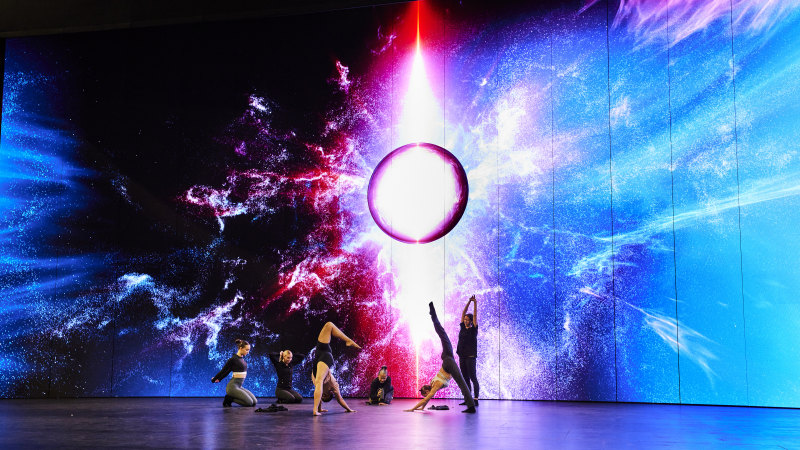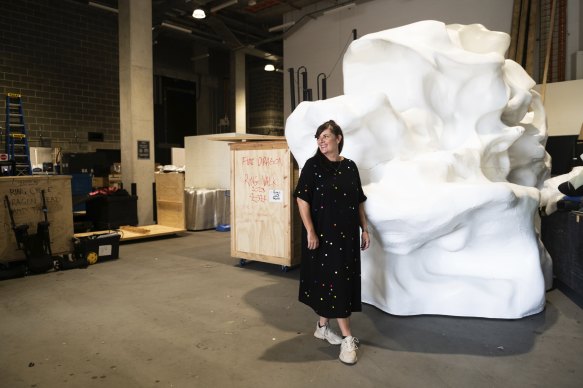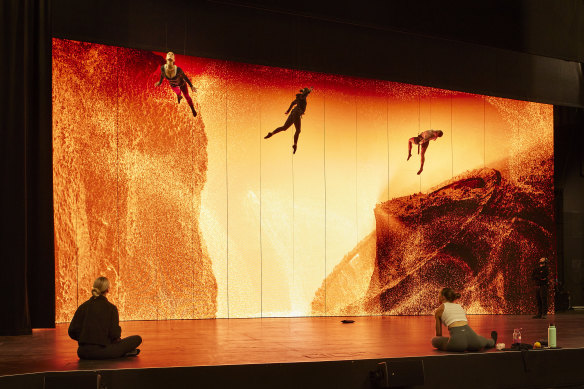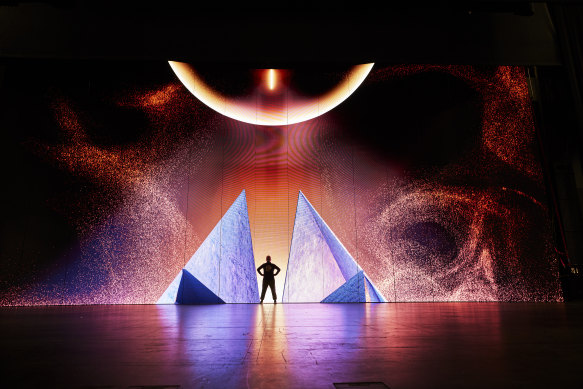By Nick Galvin
Save articles for later
Add articles to your saved list and come back to them any time.
In 1993 Leigh Sachwitz packed a single suitcase and left her native Glasgow for Berlin on a one-way ticket in search of adventure.
An architecture graduate from the Glasgow School of Art, Sachwitz soon found that adventure immersing herself in Berlin’s burgeoning underground house and techno scene, creating visual worlds using primitive slide projectors and Super 8 film cameras.
Leigh Sachwitz has conjured an entire visual world from Wager’s music.Credit: Rhett Wyman
“I started with old Russian machines that I could get my hands on for one Deutsche Mark at the flea market,” she says. “I was creating lights in warehouses using that type of technology. And then we moved to VHS and that was like ‘Oh my God’. And then, of course, the first Apple computer where we had a laptop and we’re like, ‘Oh my God, I don’t have to travel with my two boxes of slide projectors to a club and set up my stuff’.
“And then we got HD and then 2K, and now we’re combining the creation of imagery with a lot of these gaming engines. Now we’re at the point where we can actually create live generated content.”
Fast-forward 30 years and flora&faunavisions, the company she founded in 1999, is one of the world’s leading creators of audiovisual environments, employing cutting-edge tools that increasingly include artificial intelligence. It’s light years away from those early Berlin days.
Now Sachwitz is preparing for the opening of one of the biggest projects she and her team have tackled – the world’s first all-digital production of Richard Wagner’s Der Ring des Nibelungen (“The Ring”) with Opera Australia.
The work, seen here in a tech rehearsal, tells an epic tale of gods battling over a magical ring.Credit: Keith Saunders
Considered the Olympics of the operatic canon, a full Ring cycle consists of four separate operas totalling 15 hours of music that tell an epic tale of gods and mythical heroes battling for possession of a magical ring.
Any complete production of The Ring is a big deal but with eight mobile LED panels 2.5m wide by 8m high, video that can be triggered by the performers’ movements and hundreds of hours of computer programming, this is Wagner like it has never been seen before.
Sachwitz was first approached with the project in March 2019 and given a deadline of 18 months.
“Everyone said you’re totally insane to do that in one and a half years,” she says. “But I thought it was possible and then I started reading a bit about different people who’d done the Ring cycle and realised that actually if we do this in one and a half years, it is quite quick.”
Performers rehearse in front of one of Sachwitz’s striking backdropsCredit: Keith Saunders
In the end, the pandemic intervened and the on-again, off-again production is only finally reaching the Brisbane stage at the beginning of December.
At the beginning, Sachwitz had only the barest knowledge of The Ring and few preconceptions.
“I knew of The Ring and of Wagner and I’d worked on several operas before but I’d never worked on Wagner,” she says. “I really had to go in there and study from the beginning, which is the first step to just understand what is this about and how can we make this epic and original.”
Initially, she sat down with director Chen Shi-Zheng and costume designer Anita Yavich. For two weeks they sat in a rehearsal room and listened to many of the roles being sung accompanied by a piano reduction of the score.
“We started talking about the patterns and the rhythms and the worlds and where people are and what our vision was,” says Sachwitz. “You start looking at mood boards and picking out pictures. I’m a super visual person and the looking part of me kind-of got switched on, and then you just start sorting and searching and researching and trying to find images. And then slowly you start to throw a whole bunch of them out again and go back again, and it just goes back and forth.”
Sachwitz has avoided being too literal or prescriptive in her visual interpretation of The Ring.Credit: Keith Saunders
So at the end of that intensive fortnight of Wagner, did it all slot into place?
“I’d only still scratched the surface because at the end I was like, ‘Oh my God, did I agree to do this? This is insane. This is Wagner. What the hell was he thinking?’” she says. “Actually, the work started after those two weeks.”
‘In the end, if you don’t have a good story, then it’s nothing’
Ultimately, Sachwitz and her team were led by Wagner’s extraordinary score in all its futuristic glory.
“I’m a huge fan of the music,” she says. “It’s so bold, which is great for visuals. It’s very modern, almost science fiction. I think he was a visionary of his time.”
She has been cautious about being too literal or prescriptive in her visual interpretation of The Ring.
“A lot of the digital design and the sets and everything is quite abstract and modern,” she says. “I think it gives you space as an audience member to think for yourself and just to listen to the music and let yourself be kind of hypnotised by the world and the environment without seeing something literal, without seeing something which puts that image into your head.”
With developments in technology unfolding at an ever faster pace, Sachwitz is excited to imagine what might be possible for opera in the near future.
“It would be so great to work on an immersive opera,” she says. “Imagine the audience could be on stage in the orchestra, they could be right next to them. Imagine that different kind of setup. So you get rid of the proscenium for a moment and create the orchestra in the middle and everyone around sitting in these beautiful worlds. It also bridges the gap between generations.”
Not that Sachwitz believes “analog” operas will become a thing of the past any time soon.
“Analog art has a place in this world and always will,” she says. “And it’s great to have so many tools and new ways of creating art for artists in the future, whether it be on stage or in a gallery or whatever. I see myself as one of the creators of that future. So I’m not painting with oil, I’m painting with interactive technology or whatever. And I think everything will coexist next to each other. And I think that’s cool.
“In the end, the bottom line is if you don’t have a good story, then it’s nothing. And we are definitely coming from the story and then looking to see what kind of technology do we need to add?”
And while Sachwitz is aware this version of The Ring might not sit well with at least some of the work’s passionate fans, some of whom will travel around the world to see a new production, she is convinced Wagner would approve.
“I think he would be super into it,” she says. “He did things no one would ever have done before, and he broke the rules and he crossed borders and he took it to the limit. It’s insane. That’s why this piece is still so popular and so well respected. Why would he want to do something which was old school when all he was doing was creating a new school at the time?”
Opera Australia’s The Ring Cycle, Queensland Performing Arts Centre, December 1 – 21
The Booklist is a weekly newsletter for book lovers from books editor Jason Steger. Get it delivered every Friday.
Most Viewed in Culture
Source: Read Full Article






